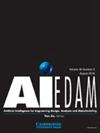基于审美尺度选择和NSGA-II的进化形态设计方法
IF 2.3
3区 工程技术
Q3 COMPUTER SCIENCE, ARTIFICIAL INTELLIGENCE
Ai Edam-Artificial Intelligence for Engineering Design Analysis and Manufacturing
Pub Date : 2022-11-04
DOI:10.1017/S0890060422000178
引用次数: 0
摘要
在产品更新速度快、竞争激烈的时代,审美设计在各个领域越来越重要,顾客的审美感受在很大程度上影响着他们的购买偏好。然而,由于评价模糊,对美感的量化仍然是一个非常主观的过程。从美学角度确定造型参数一直是一个难点。美学测量最近作为一种突出的工具出现,它使用的是从美学理论中衍生出来的公式。但现有研究表明,为了在实际使用中可靠,需要采用确定性和客观的方法进行定制。为了促进这一应用,本文提出了一种结合美学尺度选择和参数优化的进化形式设计方法。在总结初始美学维度的基础上,进行基于专家决策和粒子群优化(PSO)的美学维度选择。在过滤美学维度后,采用NSGA-II(非支配排序遗传算法)对设计参数进行优化。采用三个准则对设计方案得到的pareto解的质量进行评价,对交叉变异概率和种群大小进行敏感性分析。通过对自行车形态设计的实验表明,提出的进化形态设计方法可以快速生成多种多样的美学设计方案。这对于产品重新设计和创新的新产品开发都非常有用。本文章由计算机程序翻译,如有差异,请以英文原文为准。
An evolutionary form design method based on aesthetic dimension selection and NSGA-II
Abstract In the era of rapid product update and intense competition, aesthetic design has been increasingly important in various fields, as aesthetic feelings of customers largely influence their purchase preferences. However, the quantification of aesthetic feeling is still a very subjective process due to vague evaluations. The determination of form parameters according to aesthetics is difficult hitherto. Aesthetic measure recently arises as a prominent tool for this purpose using formulas derived from aesthetic theory. But as revealed by existing studies, it needs to be customized with deterministic and objective methods to be reliable in practice use. To facilitate this application, this paper proposes an evolutionary form design method, integrating aesthetic dimension selection and parameter optimization. After summarizing initial aesthetic dimensions, aesthetic dimension selection based on expert decision-making and particle swarm optimization (PSO) is carried out. With filtered aesthetic dimensions, design parameters are optimized with NSGA-II (non-dominated sorting genetic algorithm). The quality of pareto solutions obtained to be design schemes is assessed by three criteria to conduct sensitivity analysis of cross and mutation probability and population size. Our experiment using bicycle form design shows that the proposed evolutionary form design method can generate numerous and variant aesthetic design schemes rapidly. This is very useful for both product redesign and innovative new product development.
求助全文
通过发布文献求助,成功后即可免费获取论文全文。
去求助
来源期刊
CiteScore
4.40
自引率
14.30%
发文量
27
审稿时长
>12 weeks
期刊介绍:
The journal publishes original articles about significant AI theory and applications based on the most up-to-date research in all branches and phases of engineering. Suitable topics include: analysis and evaluation; selection; configuration and design; manufacturing and assembly; and concurrent engineering. Specifically, the journal is interested in the use of AI in planning, design, analysis, simulation, qualitative reasoning, spatial reasoning and graphics, manufacturing, assembly, process planning, scheduling, numerical analysis, optimization, distributed systems, multi-agent applications, cooperation, cognitive modeling, learning and creativity. AI EDAM is also interested in original, major applications of state-of-the-art knowledge-based techniques to important engineering problems.

 求助内容:
求助内容: 应助结果提醒方式:
应助结果提醒方式:


